I had an email today asking me about edible flowers and companion planting and it reminded me that I have long been intending to compile a list of edible flowers which can be used for companion planting. I have got an initial list but would really love to hear from anyone with an interest in this subject so that together we can compile a comprehensive list. As I love nothing better than a beautiful allotment full of fruit, vegetables and edible flowers it makes sense to plant them all together in a way which allows them to benefit each other as much as possible. I would love to hear how you do this – please let me know.
The easiest way I have found is to simply grow as many edible flowers as possible on your vegetable plot or allotment which attract beneficial insects. Really easy to grow edible flowers which are on the RHS Perfect for Pollinators list include nasturtiums, chive flowers, cornflowers, single-flowered calendula and, one of my absolute favourites, borage. We always grow borage along the bottom boundary of our allotment and you can hear the buzzing of bees almost before you can even see our allotment! Our of our neighbours has a few beehives and he loves the fact that we have so much borage growing, as well as all our cornflowers.

Borage at our allotment
Another favourite of mine (and our local bees) is chive flowers. They look beautiful and taste delicious.

Chive flowers and a happy bee last summer
So, on to other edible flowers and companion planting – here is my list so far:-
Borage – said to enhance the flavour of strawberries
Lavender – I have heard that lavender can benefit cabbages and cauliflowers as it can help ward off pests – I presume the cabbage white butterfly? The same goes for carrots and leeks in terms of deterring pests.

Lavender as a companion plant?
Nasturtiums – said to attract blackfly away from other vegetables so a good companion for any vegetables which are susceptible to blackfly BUT I have never been sure about this because you will then risk losing your nasturtium crop! In addition, the peppery leaves are said to ward of insects such as cucumber beetles and squash vine borers making them suitable companions to pumpkins, squash and cucumbers.
Chive flowers – plant near carrots as the smell of the chives can help mask the smell of carrots and help deter carrot roof fly
Calendula – can attract hoverflies to the garden, which are natural aphid predators. May also be planted near to cucumber plants to help trap cucumber beetle (although you may lose your calendula crop). I have heard that if you then plant next to radishes this will in turn deter the cucumber beetle from the calendula (and radish flowers are edible by the way!)
French Marigolds – often interplanted with a number of vegetables, including tomatoes, as they are said to repel harmful insects. Avoid planting French Marigolds next to beans as they are said to stunt their growth. French Marigolds can attract hoverflies which in turn feed on aphids so may benefit any susceptible vegetable they are planted close to.
If you do not already know about it, try looking up “Three sisters planting” on the internet. That can work well by combining sweetcorn, squash/courgettes and beans or climbing peas – and as you can harvest edible flowers from squash, courgettes and many peas and beans this counts as using edible flowers for companion planting! This method is worth thinking about, especially if you are short of space or want to maximise your ground cover and try to minimise the weeds.
I am quite sure the list of edible flowers for companion planting is much more extensive than this – I would love to hear your experiences and ideas.
